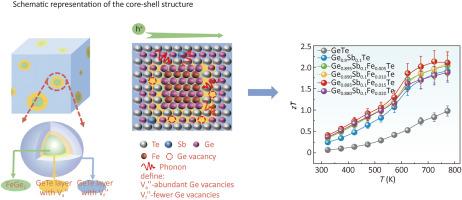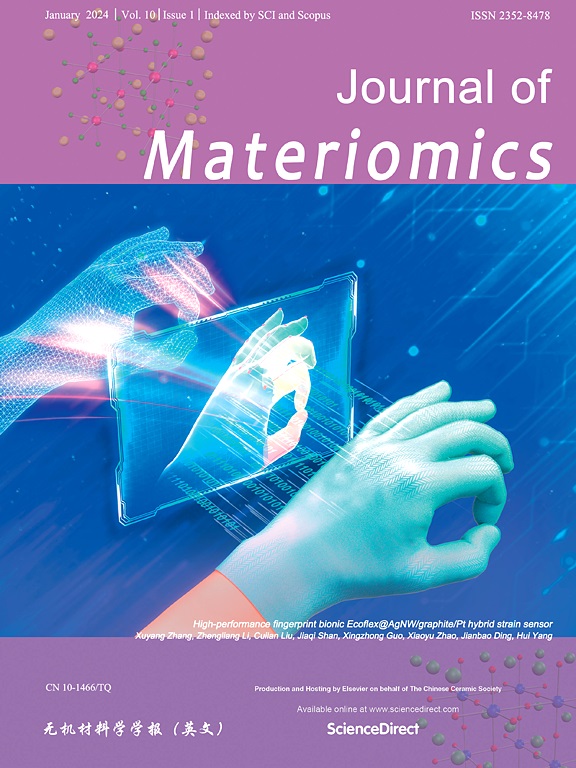A core-shell structure to realize high thermoelectric performance in Fe and Sb co-doped GeTe materials
IF 9.6
1区 材料科学
Q1 CHEMISTRY, PHYSICAL
引用次数: 0
Abstract
GeTe is a promising medium-temperature thermoelectric material. However, an excessively high concentration of Ge holes leads to a high hole carrier concentration, which can degrade its performance. Though carrier concentration reduction via doping has been pursued as a principal optimization approach, the strong interdependence between key transport parameters and carrier concentration severely limited the overall enhancement efficacy. In this work, a simple composite method is employed to achieve synergistic optimization of carrier concentration and carrier mobility, thereby increasing the power factor and reducing the lattice thermal conductivity. Sb and Fe form a core-shell structure, which effectively scatters phonons and reduces the lattice thermal conductivity, achieving a minimum value of 0.59 W⸱m–1⸱K–1 at 723 K. Additionally, Fe doping enhances the effective mass, improves the Seebeck coefficient, and significantly boosts the power factor, which reaches a peak value of 43.0 μW⸱cm–1⸱K–2 at 623 K. The results demonstrate that the sample Ge0.885Sb0.1Fe0.015Te achieves a maximum zT of approximately 2.13 at 723 K and an average zT (zTavg) of 1.43 within the temperature range of 323 K to 773 K. This work provides an effective path to enhance the performance of GeTe-based thermoelectric materials.

采用核壳结构实现Fe和Sb共掺GeTe材料的高热电性能
GeTe是一种很有前途的中温热电材料。然而,过高的锗空穴浓度会导致空穴载流子浓度过高,从而降低其性能。虽然通过掺杂降低载流子浓度是一种主要的优化方法,但关键输运参数与载流子浓度之间的强烈相互依赖性严重限制了整体增强效果。本文采用简单的复合方法,实现载流子浓度和载流子迁移率的协同优化,从而提高功率因数,降低晶格导热系数。Sb和Fe形成核壳结构,有效散射声子,降低晶格导热系数,在723 K时达到最小值0.59 W⸱m-1⸱K - 1。此外,Fe的掺入提高了有效质量,提高了Seebeck系数,显著提高了功率因数,在623 K时达到峰值43.0 μW⸱cm-1⸱K - 2。结果表明,样品Ge0.885Sb0.1Fe0.015Te在723 K时zT最大值约为2.13,在323 ~ 773 K温度范围内zTavg平均值为1.43。本研究为提高gete基热电材料的性能提供了一条有效途径。
本文章由计算机程序翻译,如有差异,请以英文原文为准。
求助全文
约1分钟内获得全文
求助全文
来源期刊

Journal of Materiomics
Materials Science-Metals and Alloys
CiteScore
14.30
自引率
6.40%
发文量
331
审稿时长
37 days
期刊介绍:
The Journal of Materiomics is a peer-reviewed open-access journal that aims to serve as a forum for the continuous dissemination of research within the field of materials science. It particularly emphasizes systematic studies on the relationships between composition, processing, structure, property, and performance of advanced materials. The journal is supported by the Chinese Ceramic Society and is indexed in SCIE and Scopus. It is commonly referred to as J Materiomics.
 求助内容:
求助内容: 应助结果提醒方式:
应助结果提醒方式:


